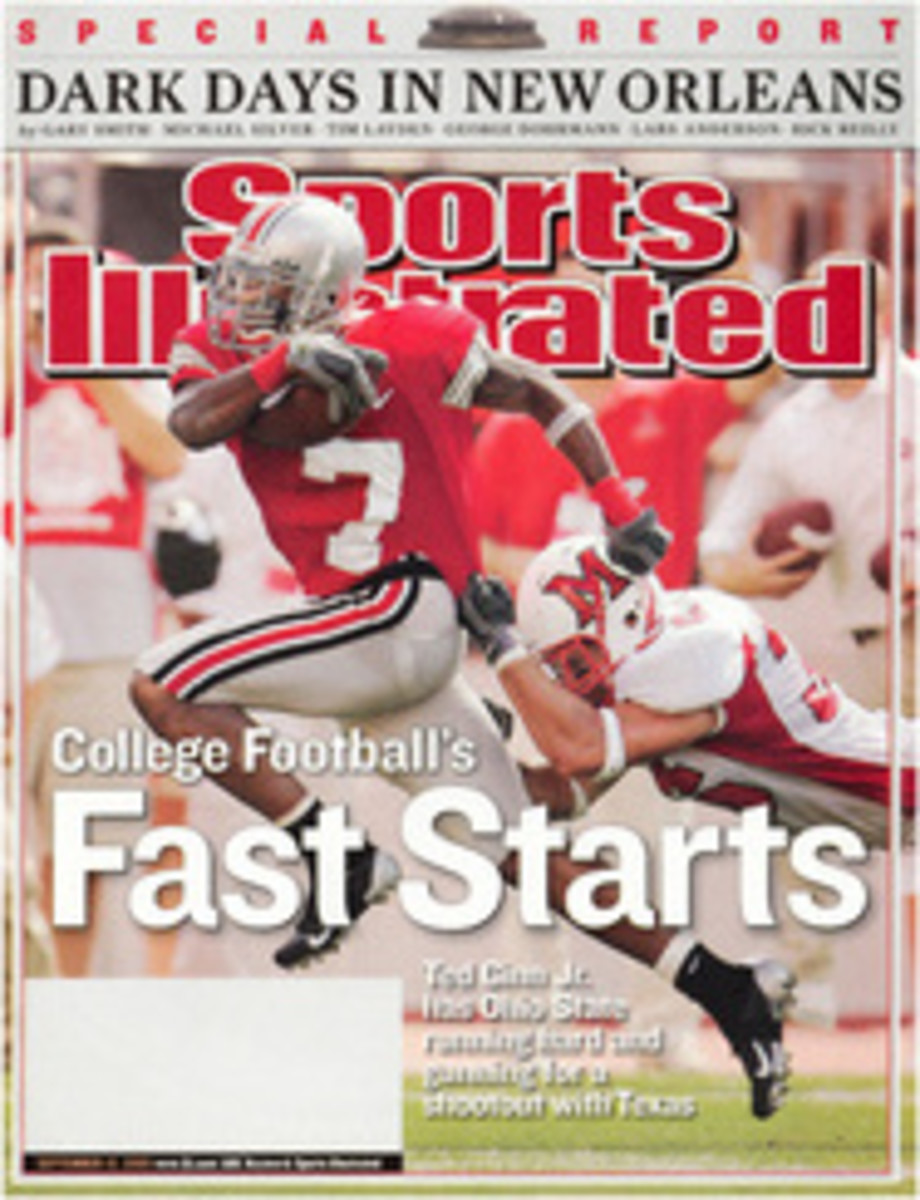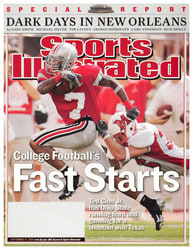
Going It ALONE
Theater buffs may remember Dames at Sea, the 1968 Off-Broadway musical in which a battle-ax of a leading lady performed on the deck of a battleship. Well, late last month a tugboat of a dame played at sea off Broadway. About a mile off Broadway--in the Hudson River. The British sailor Ellen MacArthur, who in April, at age 28, became the youngest person to receive a damehood, was sailing her trimaran around Manhattan as a tune-up for an upcoming assault on the transatlantic west-to-east solo record. ¶ Steering a 75-foot multihull through the bobbing waters that encircle the Big Apple is like driving a 12-ton semi down Fifth Avenue without brakes.
The narrowest passages are treacherous obstacle courses of barges and ferries and debris ranging from half-submerged refrigerators to floating credenzas. "While piloting this boat, you must stay vigilant and never lose your focus," says MacArthur, perhaps the most vigilant, focused pilot in nautical history. "In competition I assume the worst is going to happen at any moment. The second I become complacent, it's all over."
MacArthur has been a national hero in England since 2001, when at the maddeningly precocious age of 24, she finished second in the Vendée Globe, the world's toughest single-handed sailing race. If not for a cruel failure of equipment--a forestay snapped four days before her finish--she could well have won. She became a British national treasure last February by completing a circumnavigation in 71 days, 14 hours, 18 minutes and 33 seconds, scything more than 32 hours off the standard set by Francis Joyon of France in 2004. At a homecoming reception in the English harbor of Falmouth, a sign read, ELLEN RULES THE WAVES.
The French call this 5'3" skipper la petite Britannique, but what makes MacArthur extraordinary is not that she's a woman in what has always been a man's sport, but that she has such extraordinary resourcefulness and endurance. During her 27,354-mile voyage last winter, she was battered by mountainous waves and 60-knot winds, dodged icebergs and nearly collided with a whale off the west coast of Africa. To maintain speed, she endlessly trimmed the boat: Over one exhausting 12-hour stretch off the coast of Chile, she had to change the sails 14 times--with each adjustment taking about 30 minutes. Twice, she had to fix the rigging by shimmying up the 100-foot mast in a near gale with the boat going full tilt. "Every muscle in my body feels like it's been torn," she radioed her base team back in the Isle of Wight. "I've got massive bruises on my left leg from where it was jammed between the sail and the mast. Everything hurts so much--if I move it hurts. I just want the pain to go away."
Living on freeze-dried rations, she averaged four hours of shuteye a day, snatching sleep in 20-minute chunks by curling up on a beanbag in the cuddy, a hobbit hole between the cockpit and the cabin. "You're empty and you're totally knackered, but you can't let yourself get to the state of hallucination," says MacArthur. "You can't switch off--you've got to constantly renew your energy."
While catnapping, she would clutch either the mainsail rope or the remote for the autopilot system, ready to react the instant a squall hit. "Ellen gets quite close to the edge of what a human being can handle," says Rudi Stein, her boat's electrician. In the rarefied world of techno-yachting, he notes, "You can't win if you don't push yourself to the limit, but if you push yourself over your limit, you can't win either."
In her 2002 autobiography, Taking on the World, MacArthur comes off as pragmatic, efficient, brisk, practical, well-organized and, above all, realistic--not self-deluding, as many of the great adventurers tend to be. Her dedication to detail steers a course between obsessive and fanatical. Aware that a sailor in a previous Vendée Globe bit off his tongue after being struck in the head and had to sew it back on, MacArthur prepped for the same scenario by practicing on a flap of pigskin. "What drives me is a desire to test what I'm capable of," she says.
For all her relentless ambition, MacArthur shuns celebrity and rejects every endorsement offer. About the only venture she has lent her name to is the Ellen MacArthur Trust, a charity that arranges sailing trips for cancer-stricken youngsters. "Being a sailor is hard, but I chose the career," she says. "Those kids go through things that are much harder than anything I can ever imagine, with smiles on their faces and a great love of life. That's real courage."
Born in the flyspeck village of Whatstandwell in the landlocked county of Derbyshire, MacArthur is one of three children, and the only daughter, of two schoolteachers. She was bitten by the water bug at age four, when an aunt took her sailing at Burnham-on-Crouch. "I still remember the feeling of freedom when we got out of sight of land," she says. "I thought, We can go anywhere!" In grade school she took a weeklong sailing course. The youngest and smallest student, she capsized 11 times on Day One and finished last or next-to-last in every race. "On my way home I promised myself never to be last again," she says. "No matter what it took."
She saved her lunch money to buy a fiberglass dinghy and kept it on a pond near her home. At 17 she upgraded to a Corribee, a 21-foot sailing yacht, which she rebuilt and renamed Iduna, after the Norse goddess of eternal youth. The following year she decided that tooling around Britain alone "seemed to be the most natural thing to do." She and Iduna took 51/2 months to make the journey.
Cobbling together a slender living as a sailing instructor, MacArthur quietly built her reputation on the racing circuit, then became an overnight sensation four years ago in the Vendée Globe, when she and her 60-foot monohull, Kingfisher, chased the winner, Michel Desjoyeaux, to the far corners of the planet for 94 days.
MacArthur insists that each of her crafts has a distinct personality. "My trimaran is very strong spirited," she says of the boat she calls Moby. "That's why I had eyes painted on her hull--so she could see where she was going." Moby speaks to MacArthur through her sails, her rudders, her central daggerboard. "Every rope, every beam has its own voice," she says. When Moby cuts through the scowling seas, those voices harmonize like the Mormon Tabernacle Choir.
Soon MacArthur and Moby will be riding the swells again--this time in an attempt to claim the fastest time for a solo west-to-east crossing of the Atlantic. It won't be easy. In establishing the record of six days, four hours, one minute and 37 seconds in July, her old rival Joyon shaved a staggering 22 hours off the existing mark, which MacArthur had missed by 75 minutes the summer before. "Francis had perfect weather and a boat that never broke down," she says.
Additional frisson will be provided by another French sailor, Thomas Coville, whose 60-footer is moored near Moby at North Cove Marina in lower Manhattan. Coville wants the record too. When the tailwinds are deemed favorable, he and MacArthur may well set off at the same time.
MacArthur welcomes the challenge. "There's a far greater chance that I won't break the record than I will," she says, "but it's not impossible."
Redefining the impossible, after all, is MacArthur's specialty.
SI.com/adventure
"I assume THE WORST IS GOING TO HAPPEN," says MacArthur. "The second I become complacent, it's all over."
MacArthur insists that each of her crafts has a distinct personality. "My trimaran is VERY STRONG SPIRITED," she says.
PHOTO
Photograph by Joe McNally
RIGGED TO WIN
MacArthur and Moby are eyeing a record crossing of the Atlantic.
PHOTO
JOE MCNALLY
PHOTO
MARCEL MOCHET/AFP/GETTY IMAGES (TRIMARAN)
CRAWL SPACE
During her sails, MacArthur grabs sleep when she can in this cuddy.
PHOTO
LEE DURANT/AFP/GETTY IMAGES (TOP)
SALUTED
MacArthur's record earned a Falmouth regatta and a Laureus award from Owen Wilson (left) and Tony Hawk.
PHOTO
DAVID CANNON/GETTY IMAGES

